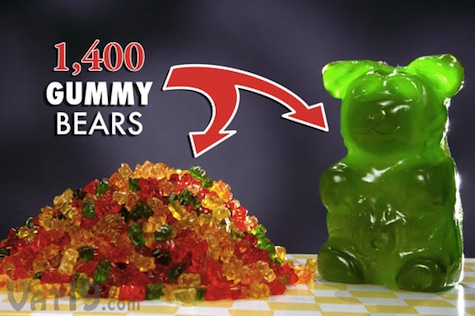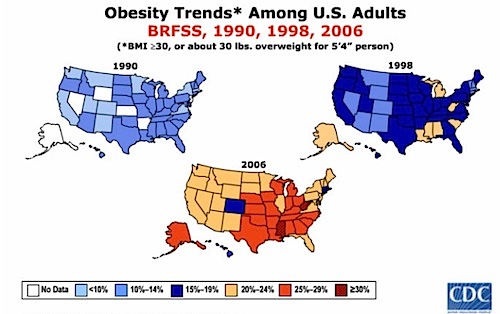Some of my favorite things in life (and many of my guilty pleasures) revolve around gustatory delights. But unfortunately, when the family economics falls into question, one of the things that may get sacrificed is the food quality of the household. Is it the case in your home that when you want to cut costs or save up for something big, you decide to start stocking up on potatoes? Nutritious and filling, but it’s starch and more starch.
I suppose that’s not so bad considering the alternative, which is to go for dollar meals at your local fast food station. Or the pizza place. Or the doughnut shop. That last one happens because we want to give ourselves treats even as we try to make sacrifices. Before long though, the hard choices we have to make at the grocery store and the dining table may end up actually adding inches to our waistlines!
So we know that lots of things make us fat — inactivity and the sedentary lifestyle and an unhealthy diet. What’s interesting though is that there are studies that link the cost of food to obesity as well. Apparently, cheap food can make you fat.
I have a sweet tooth and love candy myself, but this is scary (it has diabetes written all over it). Images from Vat19.com. Bigger isn’t always better — especially food portions!


Lower Food Costs = Obesity in America
There are lots of studies about this matter. More and more people are spending less money at the grocery store in order to keep more money in the bank. However, what many people fail to realize is that the cheaper the food is, the more processing it’s likely to have undergone, and the more calories it packs into each and every mouthful.
You can check out the U.S. obesity trends in this incredible interactive map (graphic). It shows the “fattening” of America through the years. Click on the image to see more.
ABC World News Sunday did an entire expose on the link between food cost and obesity, citing that “eating healthy can cost more.” Here’s why: highly processed foods contain higher amounts of sugar and fat in order to make it more palatable to us. It doesn’t hurt that these ingredients are cheap as well as tasty.
Foods high in fat and sugar also seem to have addictive properties. From my personal experience, I get stronger food cravings when I’ve been eating “bad” food. Junk food, sugar, simple carbs and processed food high in sodium aren’t just unhealthy on their own, but also trigger cravings. It’s why it’s hard to “stop at just one” piece. When I make the conscious decision to cut out these foods from my system, I go through a “withdrawal” phase where I’m miserable, then bounce back with fewer and fewer cravings after a few days. Admittedly, I go through cycles like this, but this is how I wean myself off of the bad stuff.
Then there’s the case of Morgan Spurlock, the brains behind such documentary phenomena as “Super Size Me” and “30 Days.” In “Super Size Me,” Morgan takes a look at what happens to the human body when subjected to nothing but fast-food drive-through fare. More specifically, he wanted to know what would happen to him if he ate nothing but McDonald’s for thirty days. It’s not like this stuff could kill you…could it? Come to find out, maybe it can. In just thirty days, Morgan’s body chemistry had decayed to the point that his doctors were genuinely worried about whether or not he would be able to complete the experiment without suffering a heart attack. He survived, but needless to say, he learned a lot about himself and the effects that an excess of cheap, highly processed food would do to his body. His wallet wasn’t the only thing that enjoyed a few extra inches of expansion around the middle!
Some Tips:
- Don’t sacrifice your health when cutting back. Instead of scrimping on food, consider saving money on things like cable or satellite TV instead.
- Find out if there are ways you can earn more or increase your income.
- Go for quality food rather than quantity. Cut back on portions but enjoy the food you buy and make!
- Treating obesity and the health problems that come with obesity is way more expensive than any kind of food menu you can come up with. Health is priceless so I’d invest in it!
Smart, Healthy Food Choices & Tips To Fight Obesity
While all this may be true, I’ve discovered that it’s a whole lot tougher to eat healthy while trying to maintain a strict budget. But the good news is that it can be done. There are several simple ways for you to save money on food and groceries and still eat healthy.
1. Conscientious Shopping
Shopping carefully and buying fresh fruits and vegetables when they are in season (and therefore plentiful) will help cut costs tremendously.
2. Alternatives to the Grocery Store
Check out local farmer’s markets and co-ops instead of your local grocery store. You’ll be amazed at the quality and savings you can get from local growers.
3. Clip Those Coupons!
This may be one of the most obvious, but least utilized, ways to still eat healthy on a budget. Coupons are not just for grandmothers! And you can find coupons everywhere nowadays and for just about everything. You can even pick up printable coupons online. So there should be no excuse for quickly printing off a few before you head out the door to your local store.
4. Gardening?
I know what you are thinking: when do I have time for gardening? However, starting your own vegetable garden is another cost-conscious idea. You can get all of your vitamins and minerals at a huge discount. Growing just a small garden won’t take all of your spare time either.
5. Know What You Are Buying
Avoid buying items that don’t label — or worse, don’t even remember — where they came from. The foods have most of the nutritive value stripped away, leaving behind nothing more than a fat and sugar-cured shell of their former selves.
6. Cheaper Organics
Although many organic items are more expensive, you can still buy organic food and eat well for less money. It all comes down to knowing what you are buying, and doing your research.
7. Be Creative
It’s amazing how cheap, simple ingredients can be transformed into highly tasty dishes. But it may take some effort to be a creative cook. You’ll need to get into the habit or build a little experience in this area.
Healthy Food Choices That Are Rich In Nutrients
Here’s a quick list of good cheap but healthy foods straight out of WebMD to keep stocked in your pantry. These foods cost $2 or less per package:
1. Brown Rice – 170 calories for 1/4 cup
2. Whole-Wheat or Multigrain Pasta – 190 calories for 2 ounces (dried)
3. 100% Whole-Wheat Bread – 180 calories, 2 slices
4. Oats – 140 calories for 1/2 cup (dry)
5. Frozen Vegetables – 82 calories for 1 cup
6. Potato – 168 calories for 1 medium to large potato
7. Fresh Spinach – 20 calories for 4 cups
8. Canned Refried Beans – 120 calories for 1/2 cup
9. Canned Tuna – 70 calories for 6 ounces
10. Canned Marinara Sauce – 80 calories for 1/2 cup
11. NulaidReddi Eggs (egg substitute) – 30 calories for 1/4 cup
12. Frozen Edamame (Soybeans) – 120 calories for 1/2 cup shelled
Besides these tips, you can also check out our suggestions on how to lose weight while spending less on food. Most importantly, just be conscious of what you are putting into your body, and don’t fall victim to the cheap food trap.
Copyright © 2011 The Digerati Life. All Rights Reserved.


{ 11 comments… read them below or add one }
Many healthy foods are an acquired taste, but it is worth acquiring it! I have become a lover of salads, raw food, and grilled vs.fried food. My quality of life is so much better now than before. I really prefer things like brown rice, whole wheat, whole grains and vegetables.
Thanks KrantCents. I also decided I’d shift to raw salads and found that after the initial period of trying to get used to the fare, I started looking for it more and more! On top of this, I realized it was easier to turn away red meat. It always seems that the first few days of making a food adjustment are the toughest. But once you’re over those few days, it becomes much easier! Same goes for sugar, carbs, etc. I guess you can always train your taste buds and body to like most anything (think about what it’s like if you live in a different country and have to settle for what they serve there).
I agree with krantcents. Most healthy foods can taste great, you just have to give them a chance. I personally love vegetables, couldn’t live without them, and that is because I have incorporated them so much in my diet.
I love it! Such a good post. I keep telling people that when I started bring my food instead of eating out on lunch I was actually saving money. Almost 100$ a month. I was cooking more, brining fruits and veggies, and drinking water instead of pop. But I still drink coffee. Real food is healthy. Whole foods and not processed stuff. I make my own bread, jerky, and cook alot and I am still saving money.
Good Day
When my father got sick, we all had to change our diet. It was hard for me to transition to brown rice and wheat bread. Now, I prefer these healthier choices. These are not cheaper than their alternatives. However, I’m feeling so much better now. I get to save money because I buy more organic vegetables now than pork or beef.
I think the cheap food which have the addictive qualities such as high fructose corn syrup are directly related to government subsidizing corn. The farmers in the U.S. have no incentive to grow lettuce as they do with corn and other subsidized produce. That’s why salads cost a lot more than they should. Maybe its time U.S. Government subsidized healthier options. What do you think?
The article is correct when it comes to the taste of cheap foods, I am guilty of eating these types of foods at times. I also try to eat healthy and eat whole wheat bread, pasta, and other items. I wish I could use the coupons that you print off from the internet, but the stores in my area will not take coupons for any of the coupon sites. Trying to eat better in 2011 by eating more fruits and vegetables and organic foods, the only problem is that the food is very expensive. This summer I will be starting a garden and trying to grow some vegetables.
Those gummy bears kick so much butt. Don’t suppose you know where I can buy one?
It’s crazy to think that you eat a lot more calories for cheap when they’re filled with sugar and preservatives, which means that folks below the poverty line tend to be the ones that are eating the worse. There are some community gardens in my area fighting this, but it’s a huge uphill battle against marketing and a lack of food education. Like your image of the gummy bears… really proves the point.
Equating unhealthy fast food as a cheaper alternative to healthy food is like buying a pair of running shoes from Kmart vs. Nike, and saying they’re the same thing. They’re nowwhere near the same, so you really aren’t comparing apples to apples. Science has proven that eating 8 servings of fruits/veggies daily (I know, it sounds like alot, but even a few is better than nothing) reduces your chance of heart disease later in life. Consider the cost of medical bills, physical and mental health, lost time from work, higher insurance, etc once you have a heart attack. Now that $3 “meal deal” doesn’t seem like a such a bargain, huh?
I guess there is much more to making food choices when you have a very limited budget than I first thought. Check out this eye-opening post on this subject. When you’ve gone from “clipping coupons” to “food stamps” then there may be a difference in the type of menu you have at home.